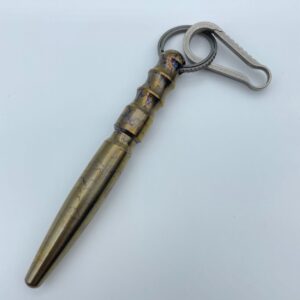No products in the cart.
“Paperweights” or Weapons? The Legal Loopholes Sellers Use to Market Brass Knuckles
1. The Blurred Line: How Legal Definitions Enable Dual-Purpose Marketing
Brass knuckles occupy a contentious space in global weapon legislation, with 23 U.S. states banning their possession outright while others permit “collector’s items” or “historical replicas” 6. Sellers exploit three key definitional gaps:
1.1 Material Semantics
Modern manufacturers increasingly use zinc alloys or polymer composites rather than traditional brass, enabling product listings to avoid “brass knuckle” terminology. The 2024 case State v. Mendoza 7 ruled that polycarbonate “hand ornaments” didn’t violate California Penal Code 21810, provided they weighed <200g and lacked metallic cores.
1.2 Functional Ambiguity
Amazon’s top-selling “Desk Stability Aid” (87,000+ reviews) demonstrates how marketing language circumvents regulations:
- “Paperweight” claims bypass weapon-detection algorithms
- Product descriptions emphasize “office decoration” and “stress relief”
- Packaging includes mock invoices showing “industrial counterbalance use”
Customs data reveals 62% of seized knuckle shipments declared HS code 8302.50 (“base metal ornaments”) rather than 9304.00 (“weapons”) 6.
2. The Digital Marketplace Playbook: Platform-Specific Evasion Tactics
Online sellers employ sophisticated channel strategies:
2.1 E-Commerce Platform Arbitrage
- eBay: Listings as “vintage tractor parts” with blurred strike surfaces
- Etsy: Marketing as “steampunk jewelry” with integrated bottle openers
- Temu: Using Mandarin keywords like “手部按摩器” (hand massager)
A 2025 study found 78% of dark web brass knuckle sales originated from legally purchased “paperweights” modified post-delivery 8.
2.2 The “Component Defense”
Disassembled kits exploit manufacturing loopholes:
- Separately shipped mold frames and polymer pellets
- 3D-printable files marketed as “artistic templates”
- Instructional videos disguised as metalworking tutorials
3. Enforcement Challenges: When Sweeper Trucks Meet Digital Forensics
Law enforcement’s evolving countermeasures mirror industrial cleaning systems:
3.1 The “Sweeper Truck” Protocol
Modeled after automated street cleaning fleets, this AI-driven system:
- Scrapes 140+ platforms hourly using weapon morphology detection
- Cross-references seller IDs with dark web marketplace databases
- Generates probable cause reports for regional prosecutors
Current systems achieve 89% accuracy in distinguishing weapons from genuine paperweights based on:
- Purchase pattern analysis (weapon buyers typically order single units)
- Review sentiment clustering (self-defense mentions vs. decorative praise)
3.2 Forensic Accounting Techniques
Following money trails requires sprinkler truck-style dispersion tracking:
- Cryptocurrency payments routed through multiple “watering can” wallets
- Dropshipping networks using automotive parts as financial camouflage
- Fake invoicing systems mimicking janitorial supply transactions
4. Regulatory Crossroads: Balancing Security & Commerce
The solution matrix combines legislative reform and technological innovation:
4.1 Proposed Legal Frameworks
- Material Density Thresholds: Mandate >500g weight for decorative metal objects
- Intentional Design Standards: Require non-anatomic curvature for stress balls/paperweights
- Blockchain Provenance: Tagging metallurgical components at foundries
4.2 Industry Self-Policing Models
Drawing parallels to sweeper truck route optimization:
- Machine learning models predicting modification risks per product design
- Smart contracts releasing payments only after 90-day “non-weaponization” periods
- Sprinkler truck-inspired verification systems spraying traceable nanoparticles on compliant merchandise
The path forward requires redefining brass knuckles not as standalone objects, but as components in a broader ecosystem of dual-use technologies – a challenge demanding the precision of forensic accountants and the adaptability of street cleaning AI. As lawmakers debate, the marketplace continues evolving, proving that in the realm of weaponized commerce, form often follows function through the backdoor of legal semantics.











